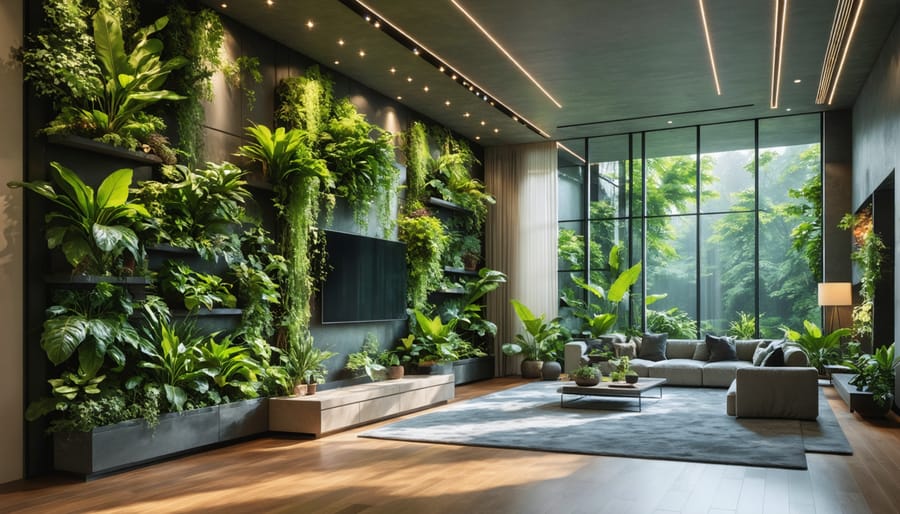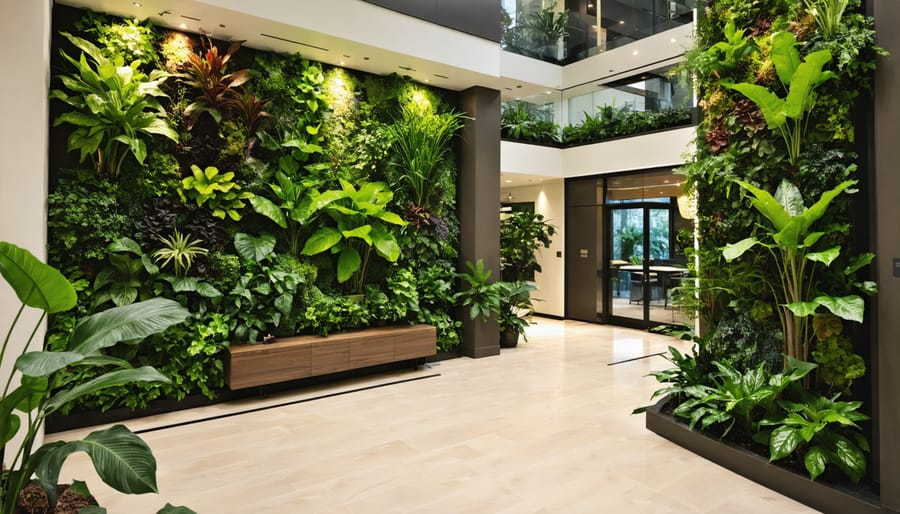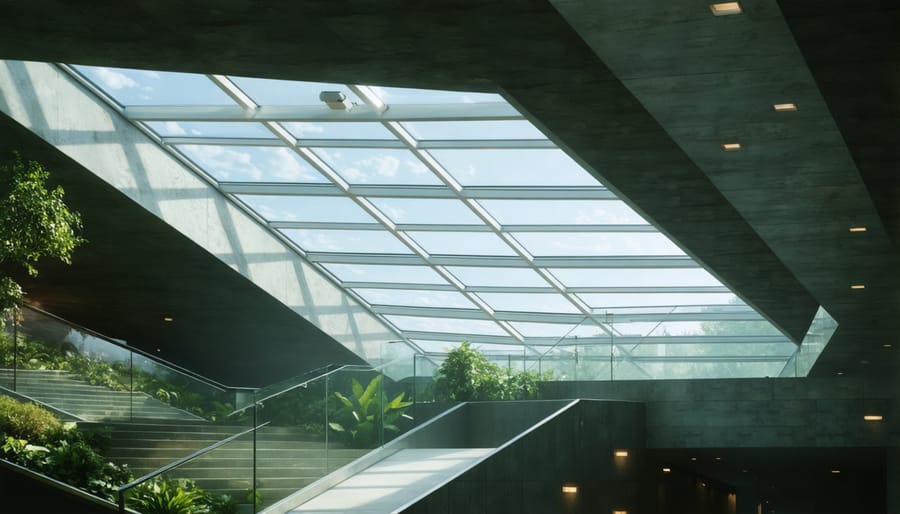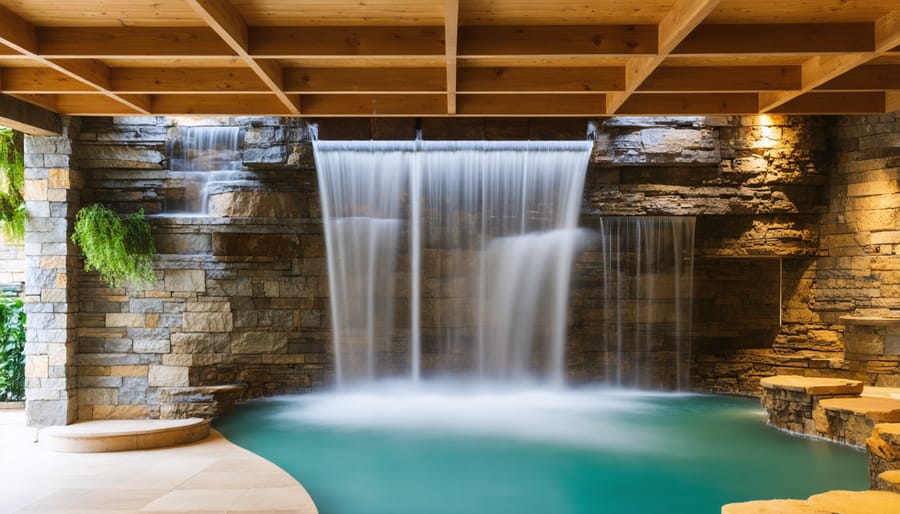
Nature Meets Structure: Beautiful Ways to Blend Living Elements Into Your Home’s Architecture
Transform ordinary spaces into vibrant, nature-connected environments by integrating living walls draped with cascading vines, installing floor-to-ceiling windows that frame natural landscapes, and incorporating water features that mimic forest streams. These cornerstone elements of sustainable interior design create immediate connections to the outdoor world while enhancing indoor air quality and reducing stress levels. Studies consistently show that biophilic design boosts wellbeing by up to 15% in both residential and commercial settings.
Natural materials like reclaimed wood beams, stone accent walls, and bamboo partitions provide authentic tactile experiences while maintaining structural integrity. Strategic placement of potted plants, moss walls, and vertical gardens maximizes visual impact without sacrificing valuable floor space. These design elements work together to create a seamless indoor-outdoor flow, transforming sterile environments into dynamic, living spaces that enhance both aesthetic appeal and occupant health.
Modern biophilic design integrates smart technology through automated natural lighting systems, self-watering plant walls, and climate-controlled greenery zones, making maintenance practical for busy homeowners while preserving the authentic connection to nature.
Living Walls That Transform Your Space
Load-Bearing Living Walls
Load-bearing living walls represent an innovative fusion of structural support and natural elements, creating a stunning architectural feature that serves dual purposes. When properly designed, these walls can support your building while hosting a thriving ecosystem of plants.
The key to successful implementation lies in the layered approach. Start with a waterproof membrane against the structural wall, followed by a rigid backing board that prevents moisture damage. The plant support system typically consists of stainless steel frames or specialized modular panels that distribute weight evenly across the wall’s surface.
For plant selection, opt for lightweight varieties with shallow root systems. Ferns, small succulents, and air plants work particularly well as they don’t compromise the wall’s structural integrity. Consider installing an automated irrigation system with moisture sensors to maintain optimal growing conditions without oversaturating the wall.
Weight distribution is crucial – work with a structural engineer to calculate the maximum load capacity, including plants at full growth, soil, and water retention. Most systems use lightweight growing media rather than traditional soil to minimize stress on the structure.
Maintenance access should be incorporated into the design through strategic placement of service panels or stepping platforms. Regular inspections of both the plant health and structural elements ensure long-term success and safety. Remember to include proper drainage systems at the base to manage excess water and prevent structural damage.

Room Dividers That Breathe
Transform your living spaces naturally with plant-based room dividers that serve both form and function. These living partitions create distinct zones while maintaining an open, airy feel that traditional walls simply can’t match. Living walls and vertical gardens can act as stunning room separators, filtering air and adding a vibrant splash of nature to your interior design.
Consider bamboo screens interwoven with climbing vines, or custom-built shelving units filled with potted plants at varying heights. These green dividers not only partition spaces but also improve indoor air quality and acoustic properties. For a low-maintenance option, try incorporating preserved moss panels or air plants, which require minimal care while still delivering that crucial connection to nature.
DIY enthusiasts can create modular plant dividers using stackable planters and metal frames, allowing for easy customization and flexibility. Choose plants like pothos, spider plants, or peace lilies that thrive indoors and naturally purify the air. For added functionality, integrate grow lights into your divider design to ensure your plants stay healthy year-round.
Remember to consider light requirements when positioning your living divider. Place sun-loving plants where they’ll receive adequate natural light, and opt for shade-tolerant varieties in darker areas. With proper planning, these breathing barriers can transform your space into a harmonious blend of functionality and natural beauty.
Natural Light Integration
Strategic Skylight Placement
Strategic skylight placement is one of the most impactful eco-friendly home features you can incorporate into your biophilic design. The key is understanding how natural light moves through your space throughout the day. For optimal results, consider installing skylights on north-facing roof sections to capture consistent, indirect light that won’t overheat your space during summer months.
In living areas, position skylights about 4-6 feet from walls to create a natural light well that illuminates both the vertical and horizontal surfaces. For spaces where you’re planning to grow indoor plants, align skylights with plant groupings, keeping in mind that most indoor plants thrive in bright, indirect light rather than harsh direct sunlight.
Kitchen and bathroom skylights work best when placed directly above task areas, while bedroom skylights should be positioned to avoid early morning glare on the bed. Consider installing smart skylights with automated shading systems to control light levels throughout the day. For maximum impact, pair your skylights with light-reflecting surfaces like pale walls or metallic accents to help distribute natural light more evenly throughout your space.

Glass Floors and Ceilings
Glass floors and ceilings create stunning visual connections with nature, offering unique perspectives that blur the boundaries between indoor and outdoor spaces. Imagine walking across a glass floor panel that reveals a thriving garden below, or gazing up through a transparent ceiling to watch clouds drift by overhead. These architectural features bring natural light deep into buildings while creating an immersive connection to the environment.
For residential applications, glass floor panels can be installed in upper-level hallways or loft spaces, allowing natural light to filter through to lower levels. Popular locations include areas above indoor gardens, water features, or naturally lit basement spaces. Similarly, glass ceiling installations work brilliantly in bathrooms, sitting rooms, or transition spaces where you want to maintain privacy while enjoying views of the sky.
Safety is paramount when installing glass floors and ceilings. Always use laminated safety glass or triple-layered panels designed specifically for foot traffic. Modern technology offers options like switchable privacy glass that can transition from transparent to opaque, and solar-control coatings that prevent excessive heat gain. Regular maintenance is straightforward – simply clean with standard glass cleaner and inspect seals annually.
Remember to consider the placement carefully to maximize natural light while maintaining privacy and comfort throughout the seasons.
Organic Material Integration

Exposed Wood Beams
Exposed wooden beams bring an authentic touch of nature indoors while creating a striking architectural statement. These structural elements not only serve a functional purpose but also add warmth and character to any space. Whether you’re working with reclaimed timber or new eco-friendly materials, exposed beams can transform your ceiling into a focal point that celebrates natural elements.
Consider incorporating exposed beams in living rooms, kitchens, or bedrooms where their presence can create a cozy, cabin-like atmosphere. For maximum impact, opt for beams with visible grain patterns and natural imperfections that tell a story. Dark-stained beams against white ceilings create dramatic contrast, while lighter woods maintain an airy, contemporary feel.
When implementing exposed beams, consider both structural and decorative options. While structural beams require professional installation, faux beams offer a DIY-friendly alternative that achieves the same visual impact. These hollow alternatives are lightweight and can house modern amenities like lighting or speakers while maintaining the natural aesthetic.
Maintenance is straightforward – regular dusting and occasional wood conditioning will keep your beams looking fresh. In spaces with high ceilings, exposed beams can help create a more intimate atmosphere while drawing the eye upward, making rooms feel both cozy and spacious simultaneously.
Stone and Water Features
Natural stone and water features bring the raw beauty of nature directly into your living spaces, creating a powerful connection to the outdoors. Installing a small indoor waterfall or fountain adds both visual appeal and the soothing sound of flowing water, which has been proven to reduce stress and improve concentration.
Consider incorporating natural stone elements through exposed rock walls, granite countertops, or slate flooring. River rock pathways in indoor-outdoor transition spaces create an organic flow between environments, while stacked stone accent walls add texture and visual interest to any room. For a more subtle approach, try decorative stone basins or boulder sculptures as standalone features.
Water features can range from simple tabletop fountains to dramatic floor-to-ceiling water walls. A carefully placed reflecting pool in an atrium brings in natural light while creating mesmerizing water patterns on surrounding surfaces. For maintenance-conscious homeowners, self-contained water features with built-in filtration systems offer easy upkeep.
When planning stone installations, focus on local materials that match your region’s natural landscape. This not only creates authenticity but often reduces transportation costs and environmental impact. For water features, consider incorporating smart technology for automated maintenance and water conservation. LED lighting can enhance these elements after dark, creating dramatic shadows and reflections that transform your space throughout the day.
Remember to account for proper drainage and waterproofing when installing water features, and ensure stone elements are properly sealed to maintain their beauty for years to come.
Bringing It All Together
Starting Small
Starting your biophilic design journey doesn’t require a complete home renovation or a massive budget. Begin with simple, manageable elements that can make an immediate impact on your living space. Adding potted plants is perhaps the easiest first step – try placing hardy indoor plants like snake plants or pothos in well-lit corners or on windowsills.
Natural light is another accessible starting point. Simply rearranging furniture to maximize sunlight exposure and removing heavy window treatments can dramatically increase your connection to the outdoors. Consider adding mirrors to reflect natural light deeper into your spaces.
Wall art featuring nature themes or botanical prints can instantly add biophilic elements to any room. Choose photographs or artwork depicting landscapes, forests, or ocean scenes. Natural materials can be introduced gradually – swap out synthetic decorative items for wooden bowls, stone vases, or bamboo picture frames.
Creating a small herb garden in your kitchen window is both practical and biophilic. Not only does it add greenery, but it also engages multiple senses through fragrance and taste. For those with limited space, vertical garden solutions like wall-mounted planters work wonderfully.
Sound elements can be incorporated through small water features or nature sound machines. Even simple changes like switching to natural fiber textiles for throw pillows or using earth-toned paint colors can begin your transition to a more nature-connected space. Remember, biophilic design is about progress, not perfection – start small and build up gradually as your comfort and confidence grow.
Maintenance Considerations
Maintaining biophilic design elements requires consistent attention and care to ensure their longevity and effectiveness. For living walls and indoor plants, establish a regular watering schedule and monitor humidity levels. Installing an automated irrigation system can simplify maintenance while ensuring optimal water distribution. Check soil moisture weekly and adjust watering frequency based on seasonal changes and plant species requirements.
Natural light features need periodic cleaning to maintain their impact. Keep skylights and windows clear of debris, and clean them at least twice yearly. For solar tubes and light wells, inspect seals annually to prevent water infiltration and maintain energy efficiency.
Water features demand weekly maintenance to prevent algae growth and ensure proper filtration. Test water quality monthly and clean filters regularly. Consider using natural cleaning solutions to maintain eco-friendly principles while keeping water features pristine.
For natural materials like wood and stone, apply appropriate sealants according to manufacturer recommendations. Inspect these surfaces annually for wear and reapply protective treatments as needed. Natural wood elements may require refinishing every few years to maintain their appearance and durability.
Living design elements, such as green walls or indoor gardens, benefit from quarterly pruning and plant health assessments. Remove dead foliage promptly and monitor for pest infestations. Consider engaging a professional maintenance service for larger installations, especially in commercial spaces.
Establish a maintenance calendar to track regular upkeep tasks and seasonal requirements. This proactive approach helps prevent issues before they become significant problems and ensures your biophilic elements continue to enhance your space effectively.
Embracing biophilic design is more than just a trend – it’s a return to our natural connection with the environment that can transform any space into a more peaceful, productive, and healthy setting. As we’ve explored throughout this guide, implementing nature-inspired elements doesn’t have to be overwhelming or expensive. Whether you start small with a living wall in your home office or go all-in with structural skylights and indoor water features, every step toward biophilic design brings significant benefits.
Remember that successful biophilic design is about creating meaningful connections with nature, not just adding plants as decorations. Consider your space’s unique characteristics and your lifestyle when choosing which elements to incorporate. Start with one or two manageable projects, like installing natural materials or creating a small indoor garden, and gradually expand your biophilic elements as you become more comfortable.
The beauty of biophilic design lies in its flexibility – there’s no one-size-fits-all approach. As you begin your journey, focus on elements that resonate with you personally and align with your space’s functionality. Whether you’re a homeowner looking to increase your property’s value, a business owner aiming to boost productivity, or simply someone seeking a more peaceful living environment, biophilic design offers endless possibilities for creating spaces that nurture both body and soul.
